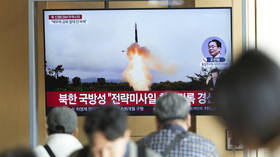Most powerful telescope ever built blasts off into space (VIDEO)
The James Webb Space Telescope, a $9 billion infrared instrument that would allow humanity to look further into the cosmos than ever before, was successfully launched into space on Saturday.
An Ariane 5 heavy rocket with NASA’s 7-ton observatory in the cargo bay blasted off from the European Space Agency’s launch base in French Guiana at 7:30am EST (12:30 GMT).
We have LIFTOFF of the @NASAWebb Space Telescope! At 7:20am ET (12:20 UTC), the beginning of a new, exciting decade of science climbed to the sky. Webb’s mission to #UnfoldTheUniverse will change our understanding of space as we know it. pic.twitter.com/Al8Wi5c0K6
— NASA (@NASA) December 25, 2021
Everything went to plan and less than a half an hour later the French-made booster released the state-of-the-art instrument – named after James Webb, who headed NASA in its formative period in the 1960s – into space.
#NASAWebb’s fairing has been jettisoned, revealing the telescope for the first time in space! Also, we have successfully received telemetry from the observatory. #UnfoldTheUniversehttps://t.co/uLUmjnfOO4pic.twitter.com/MN3xOPounA
— NASA Webb Telescope (@NASAWebb) December 25, 2021
Over the next two weeks, the telescope is going to be unwinding its antennas to eventually reach the size of a tennis court, while flying away from Earth at the speed of 40,000kph (25,000 miles per hour).
Here it is: humanity’s final look at @NASAWebb as it heads into deep space to answer our biggest questions. Alone in the vastness of space, Webb will soon begin an approximately two-week process to deploy its antennas, mirrors, and sunshield. #UnfoldTheUniversepic.twitter.com/DErMXJhNQd
— NASA (@NASA) December 25, 2021
NASA hailed the launch as “the beginning of a new, exciting decade of science,” saying that Webb’s mission “will change our understanding of space as we know it.”
The new observatory is going to become a replacement for the Hubble Space Telescope, which had been circling the Earth’s low orbit for the last three decades, primarily operating at optical and ultraviolet wavelengths.
Webb’s telescope is 100 times more sensitive than Hubble. It’s going to study the cosmos in the infrared spectrum, allowing the scientists a glimpse at the theoretical flashpoint that started the expansion of the observable universe an estimated 13.8 billion years ago.












